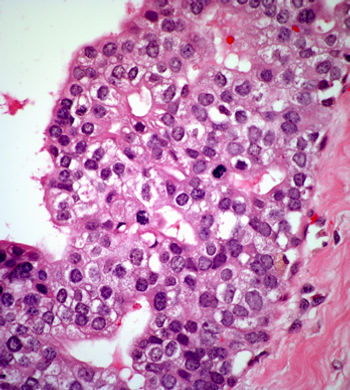
Combined temozolomide and radiotherapy offer significantly better overall survival than radiotherapy alone in patients with glioblastoma multiforme (GBM) who undergo biopsy only rather than surgical resection.

Your AI-Trained Oncology Knowledge Connection!


Combined temozolomide and radiotherapy offer significantly better overall survival than radiotherapy alone in patients with glioblastoma multiforme (GBM) who undergo biopsy only rather than surgical resection.

The US Food and Drug Administration granted the “breakthrough therapy” designation to a recombination poliovirus/rhinovirus conjugate known as PVS-RIPO, for treatment of recurrent glioblastoma multiforme.

Partial nephrectomy yields similar oncologic outcomes to radical nephrectomy for patients with stage T3a renal tumors after 5 years, according to results of a new study.

Using a risk-based model for CT lung cancer screening could prevent more deaths and reduce false positives compared with the USPSTF recommendations.

The addition of trabectedin to doxorubicin was not superior to doxorubicin alone in the first-line treatment of patients with advanced soft-tissue sarcoma.

The FDA approved lenvatinib (Lenvima) in combination with everolimus for the treatment of advanced renal cell carcinoma.

The FDA has granted a priority review to olaratumab, in combination with doxorubicin, for the treatment of soft-tissue sarcoma.

Only one in three men with prostate cancer received care in accordance with guidelines for active surveillance, according to a new study conducted in Michigan.

A new study found that FGFR3 mutation status could be used to guide anti-FGFR3 therapy in bladder cancer, as the mutation is homogeneous in radical cystectomy specimens and cancer-positive lymph nodes.

Chronic myeloid leukemia patients had a significantly increased prevalence of prior malignancies and autoimmune disorders compared with the general population.

The KEYNOTE-012 trial shows that pembrolizumab has activity and acceptable toxicity as single-agent therapy in advanced triple-negative breast cancer.

The addition of pegylated interferon-ɑ2b to dasatinib yielded promising results in a small trial of newly diagnosed chronic myeloid leukemia patients.

Afatinib resulted in improved progression-free survival compared with gefitinib in treatment-naive non–small-cell lung cancer patients with EGFR mutations.

Cancer patients have an increased risk of several common mental disorders, including depression and anxiety, beginning almost a year prior to the diagnosis.

The efficacy of ponatinib in patients with newly diagnosed CML compared with imatinib remains to be established, as a randomized phase III trial was terminated early due to concerns regarding arterial occlusive events with ponatinib.

Risk-stratification based on a biomarker and associated prophylaxis could help reduce the incidence of graft-vs-host disease in patients undergoing haploidentical transplantation.

Older soft-tissue sarcoma patients undergoing surgery derive greater benefit from radiotherapy than younger patients, according to a surprising analysis of more than 15,000 individuals.

Declines in the rates of cigarette smoking in several states mirrored declines in prostate cancer deaths between 1999 and 2010, according to a new epidemiologic analysis.

A rapid reduction in BCR-ABL transcript levels and the halving time of those levels are predictive of better outcomes in patients with chronic myeloid leukemia.

Combination therapy with bicalutamide and everolimus resulted in promising responses in a phase II trial of patients with castration-resistant prostate cancer, though a substantial proportion of patients experienced everolimus-related toxicities.

Afatinib showed significant activity in a phase II trial of patients with metastatic platinum-refractory urothelial carcinoma, and patients with HER2 or ERBB3 alterations had significantly better outcomes.

Combining trastuzumab emtansine with docetaxel both with and without pertuzumab yielded promising efficacy in a phase Ib/IIa study of patients with HER2-positive locally advanced or metastatic breast cancer.

The combination of chemotherapy and radiation therapy resulted in longer overall survival than radiation alone in certain patients with grade 2 gliomas, according to long-term results from a randomized trial.

A scoring system including several patient characteristics was found to have significant prognostic value for patients with myelodysplastic syndromes undergoing allogeneic hematopoietic cell transplantation.

First-line crizotinib therapy offered better intracranial disease control rate than chemotherapy in patients with ALK-positive non–small-cell lung cancer (NSCLC) and stable treated brain metastases.

The FDA has approved defibrotide sodium (Defitelio) for the treatment of hepatic veno-occlusive disease following hematopoietic stem cell transplantation in both adults and children.

A brain-training paradigm called neurofeedback reduced pain and other symptoms associated with chronic chemotherapy-induced peripheral neuropathy.

Patients with CML who are treated with dasatinib commonly experience lymphocytosis, and the condition is associated with higher response rates and increased survival in patients who are refractory or intolerant of imatinib.

The tyrosine kinase inhibitor pazopanib appeared to have differing effects among different histologic subtypes of soft-tissue sarcoma, according to a new study conducted in Japan.

A new study found substantial diagnostic variability from pathologists when analyzing a single breast biopsy slide. DCIS and benign lesions with atypia tended to be “overinterpreted,” meaning the risk of the disease was overestimated.